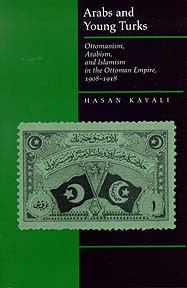Arabs and Young Turks by Hasan Kayalı

Anyone who works to undermine the historical categories used to lump disparate people and associations into grand historical movements has my ear. Reading history always makes it sound like the Selcuks all wore name badges, or Butrus al-Bustani and Naasir were talking about the exact same kind of nationalism. When I did my independent study on Arabic nationalism as formulated by the Lebanese Christians in the mid-1800's it was easy to project onto them an idea of their being the neat and tidy genesis or Arabic nationalism (not like I came up with that idea myself, I think it's a pretty well-worn Narrative). I remember getting all of the people mixed-up, confusing Abduh' and the Salafis with Rifa'i al-Tahtawi, Jurji Zaydan with the mujma'a al-lughah al-arabiya, figuring they were just equidistant and equivaluable points on the timeline of Arabic language reform and Arab nationalism.
So this book by Mr. Kayali not only places all of those characters nicely on a more measured chart, but also works consciously to dispell the myths about Arab nationalism painted by Antonius, Hourani, and the gang. He states in the introduction that there is both a temptation by Orientalists and historicist nationalists of the 60's to rewrite Arabs relationship with the Ottomans as having a crystallized national identity as far back as the 1860's, whereas he shows pretty convincingly how opposition by Arabs fell under the centralization debate as late as the war with Libya in 1911. I'm only on chapter 4 now, but he really is a super help to someone trying to piece together the evolution of Turkish and Arabic language reform and the politics of language at the same time. I am trying to write something using the resources I have here in Istanbul to have a good paper to submit for my applications to school. Don't exactly know the exact topic yet, just going over everything there is about Turkish language reform and hopefully something will pop up. I wanted to do something like trace the ideological use of the Ezafet construction (banned by the 'young turks' (you see? Kayali even challenged the notion of the young turks thereby allowing me to put those little superior parenthesis' of historical accuracy) in 1911 according to John R. Perry) in the last 150 years, going from highfalutin Ottoman to disappearance under the strict TDK rules of Isim tamlamasi to its creeping neo-Ottoman use in conservative newspapers and religious discourses. Just the story of Modern Turkey told in a grammatical construction. Any ideas?

Comments